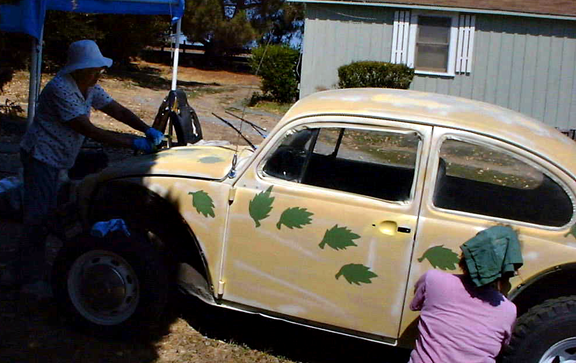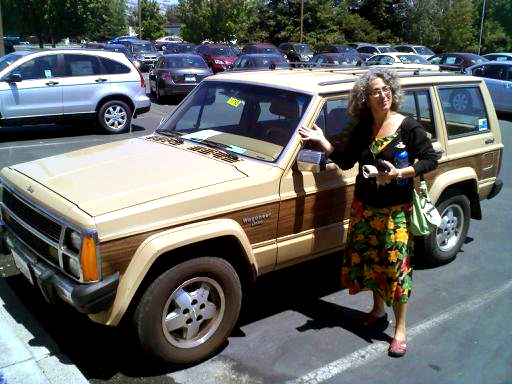
Benoit Mandelbrot died last week, of pancreatic cancer at the age of 85. While you may not have heard of him, you surely have not only heard of, but have taken enjoyment and even awe, from the mathematical model he invented.
“What?!” you may be thinking, “Are you off your nut? I hate math! I barely made it through high school geometry class!” But Mandelbrot coined the term “fractal” geometry, the structures of which, according to the math department at Princeton University, cannot be represented by classical geometry. And this math is accessible in a way that we all can see.
A fractal is a geometric pattern with geometrical and topographical features that are repeated in miniature on finer and finer scales. Such repetition independent of size or refinement level is called “self-similarity.”
The principle describes phenomena that we can all witness in nature.
Notice, for example, the similar inner branchings of a tree, a river valley, & a human lung (the latter image composed entirely of fractal algorithms). The branching repeats in very similar ways, albeit at smaller and smaller levels: trunk, to roots below and large branches above, to twigs…

*


Fractal patterns can also be seen to some degree in ferns, lightning, and more. Note how the fern coil repeats itself first in large size, then in each of the smaller coils. If we got closer, we’d see it repeating again in each of the tiny coils within the small coils, and the next and yet the next, down and down again.
 While a research scientist at IBM, Benoit Mandelbrot began to look fluctuations in the contours of coastlines. He then branched out to look for instances of similar fluctuations in all sorts of phenomena, which to other minds might seem wholly unrelated and even tangential.
While a research scientist at IBM, Benoit Mandelbrot began to look fluctuations in the contours of coastlines. He then branched out to look for instances of similar fluctuations in all sorts of phenomena, which to other minds might seem wholly unrelated and even tangential.
Through this interdisciplinary romp, he began to notice “self-similar” systems, and eventually came to the conclusion that such diverse occurrences as price trends of wheat in the stock market, the folds in mammalian brains as they grow, the clustering of galaxies, the structure of ferns, the shape of frost on your windows in winter, changes in barometric pressure over time, and (his original puzzle) the contours of coastlines and clouds, are related to one another.
Further, these patterns reveal an underlying force that pervade every aspect of life on earth.
 It seems to me that Mandelbrot thought in terms of verbs rather than nouns; focusing on moving patterns rather than the solidified results of those patterns. Philosophically, fractals seem to echo the ancient Taoist principle of yin/yang.
It seems to me that Mandelbrot thought in terms of verbs rather than nouns; focusing on moving patterns rather than the solidified results of those patterns. Philosophically, fractals seem to echo the ancient Taoist principle of yin/yang.
Mandelbrot’s NYT obit implies that he had a rough time getting these ideas across at first: “In a seminal book, “The Fractal Geometry of Nature,” published in 1982, Dr. Mandelbrot defended mathematical objects that he said others had dismissed as “monstrous” and “pathological.”
‘Twas ever thus, eh? As Mahatma Gandhi observed, “First they ignore you; then they laugh at you; then they fight you; then you win.”

Close-up of a cauliflower
The “Mandelbrot Set” can be used to mathematically explain all sorts of crooked phenomena like those listed above. Such complex things were once considered unmeasurable, but no more. He taught us a new way to think in patterns.
Do fractals reflect some universal designing set of nature?
What if the study of fractal patterns could offer not only an understanding of repeating rhythms but also the meaning of large natural phenomena?
Such a key has long been sought. In the Middle Ages, for example, the Doctrine of Signatures (a.k.a. Law of Similarities) posited that a natural object’s shape offered clues about its medicinal use.

- Hepatica leaf (photo: Frogdawn)
“And so we see in Plants and all of Nature the Word of God. Like any Scripture, Earth’s Matter is subject to our Doubt. But to the one who listens closely to its Cadence, it reveals the sweet hidden Truth.” — Reginald Johnson, On the Shapes of Leaves, 1697.
So the Hepatica plant, which has leaves shaped like the human liver, was thought to contain a healing agent for liver ailments. In fact, it was given its very name due to this.
Contemplating these mysteries, amateur meteorologist Bill Felker charted the changing patterns in barometric pressure at his home over the past 25 years. He claims to now be able to use the observed trends to predict the weather on any given day of the coming year with pretty good accuracy. Believing the structure of his data is fractal in nature, Felker conjectures,
“Some analysts believe that fractals could hold the secret key to the universe, explain the causes not only of our personal decisions but also of the outside forces that influence them. Science writer Mark Ward even conjectures that fate itself might be fractal.”
The examples of fractals usually given are visual ones like the classic fern coil. These are solid objects that we can point to, but I have a hunch that Mandelbrot’s math holds a key to understanding big patterns in motion as well. I’ve personally long been fascinated by the amazing way enormous flocks of birds can suddenly veer off in the same direction. How do they communicate? Are they watching some lead bird? If so, how? Can they do instantaneous group telepathy? Are they responding to a change in wind currents?
Maybe if we learn how to apply Mandelbrot’s principles further, we will figure out how to understand grand mysteries like that and also how to heal without violent intervention, how to make the best decisions, and how to avoid that crazy way that traffic seems to suddenly come to a stop on the freeway for no reason.
***
Mandelbrot was a Lithuanian Jew whose family fled the Nazis in 1936. What a sobering reminder of how much could be lost if “ethnic cleansers” of any ilk get their way.

For those who did not suck up the toxic Barbie-doll story that attractive people must hate math, here’s how to DIY calculate a Mandelbrot set yourself. Mandelbrot defined a fractal as “a set for which the Hausdorff Besicovitch dimension strictly exceeds the topological dimension.” Mitikoro describes how to draw one:
It’s a set of points. To draw the fractal, you must plot every point that is in the Mandelbrot set. The Mandelbrot set is defined using this formula :
z = z2 + c
|z| > 2
where z and c are complex numbers and c is the point you are testing, such as : c.real = x, c.imag = y.
If the condition is true, the point is in the set. If it isn’t true, you must iterate using the first formula. If, after a maximium number of iterations, the condition is still false, then the point isn’t in the set.
You can even model fractal patterns yourself through computers. In fact, according to the New York Times, Mandelbrot was one of the first mathematicians to use computer modeling to show mathematical principles. Witness the “Mandelbulb,” a 3-D representation based on algorithms by Daniel White and Paul Nylander.

Of course, especially for us ordinary mortals, the best way to experience these principles is to just go outside and pay attention. What Mandelbrot’s work really illustrates, in my mind, is the relationship between the large and the small; how patterns repeat at different levels and how these nested holonic relationships somehow form part of the vital matrix of life here.
Oh yes, and how, when we seek a glimpse of patterned perspective, we can see yet again how the inner workings of this planet and beyond are soul-upliftingly beautiful.
![mandelbrot_galaxy image [click to go to source]](https://indigenize.files.wordpress.com/2010/10/mandelbrot_-0-7436438870371510-131825904205330i.jpg?w=520&h=385)











![mandelbrot_galaxy image [click to go to source]](https://indigenize.files.wordpress.com/2010/10/mandelbrot_-0-7436438870371510-131825904205330i.jpg?w=520&h=385)











![Sea Pink [Grasnelken] Pollen (Image: micronaut.ch)](https://indigenize.files.wordpress.com/2010/06/sea-pink-grasnelken-pollen.jpg?w=525&h=350)















